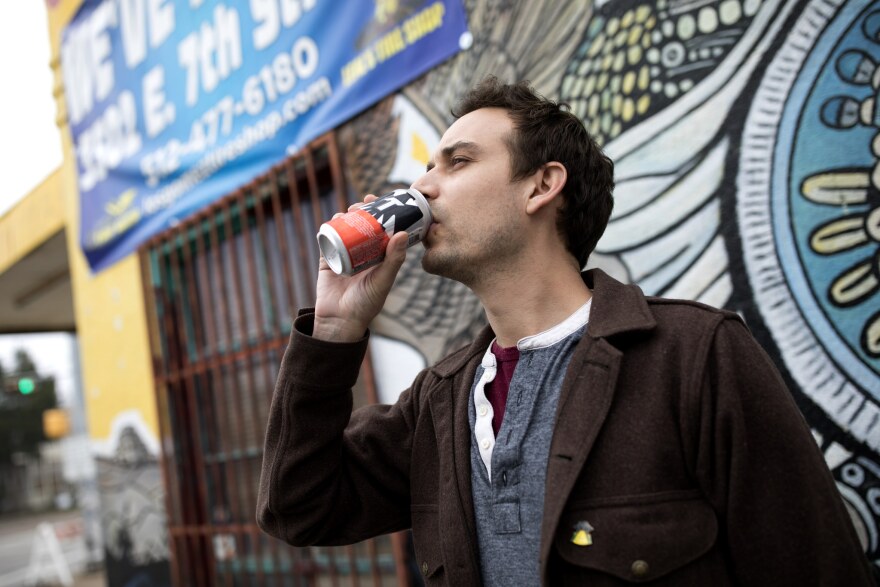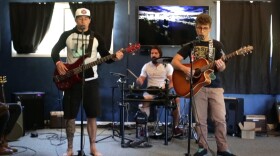Colter Sonneville had a hunch that it might be legal to walk down the street with an open beer in most of Austin’s residential neighborhoods. It started when he noticed some big signs around Chicon and East Cesar Chavez streets.
“The sign says, 'No alcohol consumption on public streets/sidewalks and pedestrian way designated area,’” he says. “‘Open glass containers prohibited.’”
The sign made him wonder if the rest of Austin was an open-container zone, so he wrote in to our ATXplained project.
Is it really legal to walk down the street with an open beer in most of Austin's residential neighborhoods?
Sonneville did some research and says he felt kind of confident about his theory. He had been testing it out for a while.

“There is a certain amount of freedom being able to drink a beer on the street and not have to worry about it,” he says while walking down East Cesar Chavez Street on a recent Friday afternoon. “It’s great.”
Subscribe to the ATXplained podcast
Dustin Lee, a lieutenant with the Austin Police Department, says Sonneville's right: City law allows people to walk around with a beer in most neighborhoods.
“If you're at your residence or you're at a friend’s residence and you're around in your neighborhood, around your house, then the law is totally OK with that,” he says.
But Not So Fast
The reason Sonneville found some signs is because there are areas where drinking in public is definitely not OK.

“What the city has done is set up some areas around the city that they don’t want to have either glass containers or they don’t want to have alcoholic beverages out on the street in the public,” Lee says.
Those six areas include downtown, an area east of I-35, the Drag, a zone that snakes from Lady Bird Lake down to Bouldin Creek, an area around East Riverside Drive and another around Montopolis.
If you put that on a map – and this person did – you’ll notice that there is a whole part of town missing: the west part of Central Austin.
That raised some red flags for Sonneville.
“If you look at the map of Austin’s no-alcohol consumption zones, and you know a little bit about Austin’s ethnic makeup," he says, "it looks like there's some racial bias involved."
East Austin, historically, has been where most black and Latino residents live. West Austin has historically been whiter and wealthier. Of course, East Austin is changing because of gentrification, but these maps were drawn up in the early '90s.
Texas law leaves it up to local governments to designate where people can and can't publicly drink alcohol.
“You know the way that I see the law is basically the Legislature wants to ensure that Texas voters and Texas citizens have the most control over how their communities deal with alcohol,” says Chris Porter, a spokesman for the Texas Alcoholic Beverage Commission.
State law gives local lawmakers the power to limit public drinking within what they call “central business districts.” Cities can also designate areas where there are homeless encampments and substance abuse centers. That led city leaders in the '90s to prohibit public consumption in most of downtown and in areas east of I-35.
East Vs. West
When asked why business districts on the West Side weren't included in those designated areas, Lee says it probably has to do with the time in which the zones were created.
As Austin has grown, he says, other areas of town have become their own vibrant business communities, where there are a lot of restaurants and bars. For example, he says, South Congress is now known as "SoCo."
Lee says in the future there could be a crackdown on public drinking on the West Side, too.
“It just kind of depends on what the focus is going to be,” he says. “My personal opinion is that as long as those areas aren't causing problems, then there's not going to be any reason to amend the ordinance.”
Join our ATXplained Facebook group
Lee also points out that many of the no-drinking areas are in parts of town where glass containers are already prohibited for public safety reasons. That means, of course, a glass bottle of Topo Chico could also get you in trouble in the six designated areas.
Citations for glass containers are rarely written in the city, however, according to data from the Austin Municipal Court. Just 240 have been written in the past five years. Most of the citations were written in parks, too, which is a whole other thing.
No-Drinking Enforcement

Municipal courts keep citation data for only five years, so showing how these public-consumption laws are enforced is limited.
From the available data, though, it turns out open-container and glass-container violations don't get written up a lot.
“The past year that I've been in the downtown area of command I've written zero tickets for somebody having a glass container,” Lee says. “Other officers have – and if it’s an issue, if it’s a problem, then they can certainly deal with that by issuing a citation."
People were more likely to get busted for drinking outside in 2013 and 2014. Police wrote up about 1,700 citations in each of those years. APD wrote up fewer than 400 citations in both 2016 and 2017, however.
“We're going to be on the positive side and assume there are less citations written because there’s more compliance,” Lee says.
One For The Road
If you look at a map of where all of the citations were written, relatively few are in actual neighborhoods – including neighborhoods on the East Side.

Sonneville says his trepidation came mostly from the fact that most of the places he’s lived – including Chicago and New York City – would never allow public drinking on the street.
“Now I feel more confident in telling people that they can actually walk around and drink a beer in most residential parts of Austin,” he says.
And that's something Sonneville has been trying to do: convince more people to walk around Austin with a beer. Previously, it was hard for him to convince people because he wasn’t entirely sure it was legal. Now he knows for sure.
“I am really excited about that,” he says. “I think it just adds to Austin’s reputation as a cool, fun place to live.”
_







